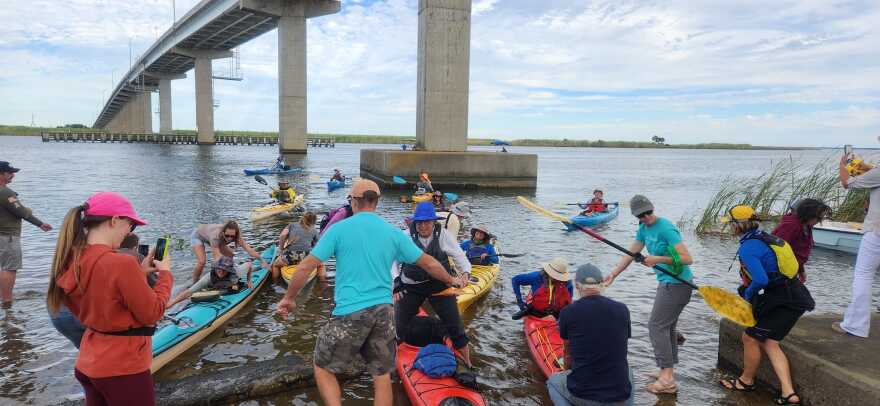The story of the Apalachicola River Basin is full of heartbreak. Once the source of livelihood for families throughout the community, the Bay collapsed in 2020, and with it the wild oyster industry. But a group of kayakers found hope on a recent trip down the length of the river.
[noise-making as kayakers arrive]
The Riverkeeper Noise Committee bangs pots and pans, rings cowbells and drums on overturned buckets to welcome the kayakers to Ten Foot Hole in Apalachicola. The kayakers have just paddled 107 miles, from Chattahoochee down the entire Apalachicola River to the Gulf of Mexico. They camped overnight on sandbars during the five-day trip that helps raise public awareness and funds for Apalachicola Riverkeeper.
“I’ve never experienced it on a kayak, and I think that’s probably the best way to experience it.”
Paula Carroll is a registered nurse from Tallahassee who has long fished and camped at the river. But this was her first time on RiverTrek.
“Because it’s slower and you see more, and you’re right there on the water, touching the water all the time,” she said. “The water, to me, looked better than it has in many, many years. It’s a little cleaner.”
After years of struggling from both natural and manmade disasters, the bay is beginning to show signs of recovery. Cameron Baxley has been the newest Apalachicola Riverkeeper for about six months. That’s the most public advocacy role in the organization. She says those signs were even more visible during RiverTrek, when the kayakers heard from experts who met them along the way.
“And we had some historians and folks that have been on this river system all their life. They’ve lived here and they’ve worked here all their lives,” she said. “And what they’ve known or seen…They’re already seeing some of the natural formations and features starting to recover and show themselves again.”
And that’s not all. Baxley says the world-famous Apalachicola Bay oysters are showing signs of a comeback, too. The bay once produced 90 percent of Florida’s oysters and 10 percent nationally. But the oyster fishery collapse was declared by the National Oceanic and Atmospheric Administration in 2012. In 2020, the bay was closed to wild oyster harvesting by the state through the end of 2025.
“I’m happy to say it’s in recovery mode,” Baxley said. “Just like I was talking about the river starting to recover now that the dredging has stopped and the snagging – it’s the same with some of the oyster reefs. It’s about 2,000 acres of oyster reefs that used to be in good shape. We’re starting to see about 56 acres of those reefs recovering.”
Baxley says some of the oysters are making it to market size, about 2 ½ to 3 inches. But if the bay opened up tomorrow, she adds, it probably wouldn’t be sustainable as a fishery.
The collapse of the bay has been blamed on drought, overfishing, impacts from the Deep Water Horizon Gulf oil spill, debris from Hurricane Michael and – some say – too much water use in Georgia. Florida’s infamous “Water Wars” with Georgia and Alabama went all the way to the U.S. Supreme Court, where a special master ruled in Georgia’s favor.
Now Riverkeeper Emeritus Dan Tonsmeire, who led the organization for 14 years, says they’re still monitoring Georgia’s water use closely. He also says the river system has improved due to good rain after years of drought.
“What we’re doing now is trying to clear the sand and things blocking the sloughs so that when the droughts do return, the water will be able to continue to nourish the backwater swamps,” said Tonsmeire. “So, we first have to remove a lot of debris out of there.”
Mary Alda Balthrop went on RiverTrek in 2017. Now she’s the chair of what’s known as the Noise Committee. She hopes to recruit enough people in the future to cheer the kayakers from further away when they arrive.
“…because in 2017, some of my friends who I used to teach with at SAIL happened to be at Riverfront Park when I was coming in. And they saw me and started chanting my name. And when you’re a mile out from the end after 107 miles, it’s awesome to have your name chanted [laughs].”
More good news: The state of Florida just authorized the Department of Environmental Protection to spend up to $5 million each fiscal year to help the city of Apalachicola with projects to improve the quality of the bay. The bill went into effect on July 1st.






